Ijraset Journal For Research in Applied Science and Engineering Technology
- Home / Ijraset
- On This Page
- Abstract
- Introduction
- Conclusion
- Copyright
Social Media Marketing Vs. Traditional Marketing: Evaluating the Success Rate
Authors: Khushi Jain, Dr. Swati Mittal
DOI Link: https://doi.org/10.22214/ijraset.2024.62335
Certificate: View Certificate
Abstract
This study delves into the comparative effectiveness of social media marketing (SMM) and traditional marketing strategies in modern business contexts. It explores the evolution, advantages, and disadvantages of both approaches, aiming to provide insights for marketers and decision-makers. By critically evaluating existing literature and analysing key metrics such as reach, engagement, the study offers practical recommendations for optimizing marketing tactics and achieving overall success in today\'s dynamic marketplace. This paper investigates the comparative viability of social media showcasing and conventional showcasing in driving brand victory. Through a comprehensive writing audit and investigation of experimental information, the consider analyses the points of interest, challenges, and effect of both promoting approaches on customer behaviour and acquiring choices. The literature review highlights the evolving landscape of marketing, with social media marketing emerging as a cost-effective and engaging platform for businesses to reach and interact with target audiences. Traditional marketing methods, while still relevant, face challenges such as excessive costs and difficulty in reaching specific demographics effectively. Empirical data analysis reveals insights into consumer preferences, trust in marketing channels, and the influence of marketing on purchasing behaviour. Findings indicate a preference for social media marketing among consumers, particularly for its ability to foster brand loyalty and provide direct customer support. However, traditional marketing methods continue to influence consumer behaviour, especially among older demographics but less as compared to social media marketing. Generally, the think about underscores the significance of embracing an adjusted approach to showcasing that leverages the qualities of both social media showcasing and conventional promoting channels. By understanding shopper inclinations and adjusting showcasing methodologies in like manner, businesses can upgrade their brand victory in today\'s energetic promoting scene. Purpose: The purpose of this study is to decide which marketing strategy—social media promoting or traditional marketing —yields superior comes about in terms of brand perceivability, client engagement, reach and generally promoting viability through acquiring conduct after seeing promotions ,It points to offer profitable experiences for businesses looking for to apportion assets reasonably and adjust their showcasing methodologies to changing buyer practices and technological scenes. Principal Research Question: Which marketing approach—social media marketing (SMM) or traditional marketing—demonstrates superior performance in terms of reach, engagement, cost-effectiveness, in contemporary business settings. Design: This study embraces a comparative research plan, examining existing writing on SMM and traditional marketing to distinguish their individual qualities, shortcomings, and advancement over time. Key measurements such as reach, engagement rates and cost-effectiveness, are inspected to evaluate the viability of each promoting approach.
Introduction
I. INTRODUCTION
A. Background of the Study
1. Brief Overview
a. Social Media Marketing
- Social media marketing utilizes platforms like Facebook, X-Platform, and Instagram for product promotion and customer engagement.
- Its power lies in establishing connections, fostering interactions, and utilizing customer data effectively.
- This approach has revolutionized consumer behaviour influence, employing strategies from content promotion to extracting personal data for resonant messaging.
- In today's widespread social media landscape, marketing through these platforms is crucial for companies to enhance brand visibility and reach new customers.
- Despite being cost-effective with increased exposure, social media marketing requires regular maintenance and may attract unintentional negative feedback.
- Also referred to as digital marketing or e-marketing, SMM aims to build brands, increase sales, and facilitate information exchange through specialized platforms like X-Platform.
- This specialized service not only connects businesses with existing and new customers but also allows marketers to track their success and obtain relevant data for analysis.
Different social media platforms and how do they work.
It leads the social media platform market. It is basic to set up an individual profile on Facebook and interface and share substance with companions and family. Facebook can be a valuable device for little business owners looking to set up a brand and picture for their company, as clients spend more time on the stage (40 minutes) than any other social media location, and half of clients like a brand or trade page.
Principal Applications: establishing a following and audience for your brand Engage with clients and supporters.
Primary Audience: Young girls between the ages of 18 and 29 contributes to the biggest age group on Facebook, which has users from all age demographics, making it the most used social media platforms.
Best time to post: Traffic is at its peak midweek between 1 and 3 p.m. Thursday and Friday engagement is higher.
Cons: The most engagement is attracted by posting just once or twice a day. Naturally, it can be challenging to stand out on Facebook because of its complex algorithm, which is always changing. At the moment, the algorithm Favors specific content depending on the past interactions and usage patterns of your fans. Remember that not all of your Facebook fans will see everything you post, even if you have X number of fans. Since they have shown the most interest in your brand, it is likely that only the fans who regularly interact with your page will see it.
Instagram could be a well-known social organizing location that empowers clients to communicate with other clients and share and trade photographs and videos. More than three hundred million people use the site, and they share more than sixty million photos every day.
Primary Audience: The 18–29 age range comprises over half of the Instagram user base.
Principal Applications: publishing and consuming aesthetically pleasing media, including images and videos.
Best time to post: 5 p.m., when most individuals wrap up their workday within the early hours of the day, when less individuals are distributing and online (2am-5am) Each day, two posts.
Cons: Instagram is not an incredible stage in the event that you are attempting to coordinate your clients someplace else, like to a particular page on your site, since it does not allow links to be inserted in customary natural posts. The other drawback is that you simply will not be extraordinarily effective on this arrange in the event that you are doing not share high-quality, outwardly engaging substance.
Users of the social networking site Twitter can send and read brief messages known as tweets, which are 140 characters in length. With more than 750 million users, the platform is an excellent way to interact with other users and establish new relationships. For some small businesses, this can be an excellent (and essential) tool, as more than half of Twitter users are also more likely to make a purchase from brands they follow on Twitter.
Primary Audience: With more of users being men and being women, young adults between the ages of 18 and 29 make up the largest demographic on Twitter.
Principal Applications in Business:
interacting with and following users who might be interested in what you have to offer interacting with your fan base, responding to inquiries, addressing grievances, etc. establishing connections with partners, supporters, and individuals in your network directing visitors to your website's additional content best time to post:
Weekdays generate more engagement for B2B companies than weekends do. Wednesdays and weekends see the highest click-through rates and engagements for B2C businesses. For best engagement, tweet at least three times a day.
Cons: Twitter's content lifecycle is much shorter than Facebook's, which is determined by a sophisticated algorithm. Since a tweet only lasts eighteen minutes, if you are not posting frequently and staying active, your content may be completely missed.
A social networking site with over 347 million members that was created specifically for the business community to connect and network. It is evident that this community finds value in the site.
Primary Audience: As one of the few social networks where the bulk of users are not between the ages of 18 and 29, LinkedIn is more popular among people between the ages of 30-64, college graduates and those with higher incomes than the average young professional.
Principal Applications:
Describe your work environment and the experience of working there.
Advertise open positions and seek out candidates for hire.
Contact and interact with other business experts.
Best time to post:
One post each workday will let you interface with almost more than half of your group of onlookers.
Cons:
LinkedIn could be a business-oriented stage adapted toward more seasoned eras, companies with a more youthful target market—think people who have not graduated from college yet—or those who are not business-centric will discover small utilize for it. For illustration, since they will be searching for modern clients, this could be a superb put for a web plan company to be, but as a little ice cream shop, it will not offer much esteem.
- Snap Chat
Snapchat is a mobile messaging app that supports both images and videos. It is no wonder that businesses are looking for ways to use this platform, which was developed in 2011, to reach their target audience, as it has one hundred million active users and has quickly become a favourite among young people.
Primary Audience: According to Snapchat user demographics, most of users are female and under the age of twenty-five.
Principal Applications:
Story telling
releasing exclusive and behind-the-scenes content
Having direct conversations and interactions with your fans
Best time to post:
It is crucial to consider both the frequency and duration of your Snapchat posts, even though there is not really a set time for them. It is unlikely that followers would want to watch two hundred seconds of your content, regardless of how thrilling you may find it.
Cons: Compared to some other platforms, Snapchat demands a lot more creativity. You must be a company with a strategy and consistent, engaging content that you can release. If you spend your entire workday in a cubicle, for instance, you might not have the greatest material to share a narrative about your company.
After determining which social media platforms would be best for you and your company, see our Beginner's Guide to Creating a Social Media Strategy for assistance in developing your strategy.
Consider Pinterest to be an online bulletin board where you can pin visual content that inspires you to do projects around the house, fashion, recipes, or other topics.
If the demographics on Pinterest adjust together with your target gathering of people, it can be an extraordinary device for businesses looking to extend activity to their web journal or site.
Primary Audience: Young women make up a substantial portion of Pinterest users. The website is well-known for being a favourite among mothers and those seeking ideas for DIY projects, weddings, and cooking.
Principal Applications: Distributing aesthetically pleasing content with links to your blog or website for additional details.
Creating interest-based boards to highlight your goods and/or content that your target audience would find interesting.
Best time to post: Throughout the day, distribute your pins to various members of your audience to avoid oversaturating their feeds with content. The best results come from posting (or reposting) about five pins every day.
Cons: Due to its extremely narrow target demographic, Pinterest is not a platform that is appropriate for everyone. Additionally, Pinterest demands that you share a variety of content on a regular basis and visually appealing images.
If your company runs a blog, for instance, you could link to it from various images that are related to the blog post. However, if you do not regularly publish new products or have content to offer, simply linking to your website will not be enough to make your business successful.
Advantages and Disadvantages of social media marketing:
Advantages
• There's a modern set of focal points with the social media promoting. Social media stages provide a powerful implies of interfacing and connection with a wide gathering of people, subsequently contributing to the enhancement of brand acknowledgment and mindfulness.
• Social media conversation with clients can advance client devotion and more grounded client connections. Littler or recently set up businesses discover it more engaging since it is regularly a less costly alternative than conventional promoting strategies.
• There are numerous points of interest to social media promoting as well. Including joins to your web journal or site on social media can help increment activity to your site and boost change rates. Besides, social media offers a real-time implies of getting client input, encouraging quick communication.
• The good thing about being both wide and focused on is another advantage of social media showcasing. Social media offers, likes, comments, and other shapes of interaction can help businesses reach a bigger group of onlookers and increment engagement. This is often especially substantial in light of the truth that clients can share substance with individuals who are not clients. On the other hand, social media stages give businesses with an assortment of focusing on choices, empowering them to recognize specific audiences' socioeconomics, interface, and habits and give them with custom-made substance.
Disadvantages
• Building a strong social media nearness requires time and work, and company proprietors regularly have to be post and associated on a standard premise.
• An intensive understanding of the various stages is fundamental for compelling social media showcasing, as is the capacity to deliver curiously substance, assess information, and make choices based on that information. Each stage is distinctive and regularly should be caught on in its claim right. Moreover, social media companies as often as possible modify their approaches and calculations, which can make it challenging to figure and maintain victory.
• Social media encourages client communication, but it also gives clients a gathering to freely discuss their grievances and complaints. This might inadvertently make an open public open Synonyms gathering, which, if managed disgracefully, seem hurt a company's notoriety.
• At last, it may well be challenging to comprehend the return on investment from social media showcasing. It can be troublesome to gage the success and return on speculation of social media promoting since it habitually requires checking a variety of measurements, assessing huge, complicated information sets, and guessing almost potential client conduct.
Evolution of social media marketing over a period
Your SMM strategy will work better if it is more focused. Leading social media management software provider Hootsuite suggests the following course of action to create an SMM campaign with performance metrics and an execution framework:
- Match SMM objectives with specific business goals.
- Find out about your target market's age, location, income, occupation, industry, and interests.
- Analyse the performance and shortcomings of your competitors in a competitive manner.
- Examine your present SMM (achievements and shortcomings)
- Make a schedule for distributing SMM content.
- Provide best-in-class content, monitor results, and modify your SMM strategy, as necessary.
b. Traditional Marketing
Traditional marketing encompasses long-established promotional methods that have demonstrated a historical history of success. This category includes various channels such as print advertisements (e.g., newsletters, billboards, flyers, newspaper ads) and broadcast media like television and radio commercials. The effectiveness of traditional marketing methods is often based on their widespread use over an extended period.
Types of traditional marketing:
- Direct Mail
Definition: Direct mail includes sending physical limited time materials, such as postcards, catalogues, or letters, specifically to a target audience through postal mail.
Purpose: Direct mail aims to reach specific individuals and create a personalized connection, often used for advertising products, services, or events.
Definition: Print marketing includes various printed materials like brochures, flyers, posters, and newsletters distributed through diverse channels.
Purpose: Print materials are designed to provide detailed information about products or services and engage the audience visually through tangible mediums.
- Broadcast
Definition: Broadcast marketing employs television and radio platforms to disseminate promotional content to a broad audience.
Purpose: This technique leverages the power of audio-visual communication to enhance brand awareness and deliver impactful messages to a wide demographic.
- Referral
Definition: Referral marketing relies on word-of-mouth recommendations from satisfied customers to attract new business.
Purpose: Encouraging existing customers to refer friends, family, or colleagues helps build trust and credibility, often resulting in increased customer acquisition.
- Billboards
Definition: Billboards involve large outdoor advertising displays strategically placed along highways, streets, or in high-visibility locations.
Purpose: Billboards aim to capture attention quickly with concise messages and visuals, making them effective for brand exposure and promoting events or products.
- Newspapers
Definition: Newspaper advertising involves placing promotional content in print newspapers.
Purpose: Newspapers are a traditional of information, and advertisements in this medium aim to reach a local or targeted audience with news-related content.
- Magazines
Definition: Magazine advertising entails placing promotional content in print or digital publications with a specific focus or niche.
Purpose: Magazines target a more specialized audience, allowing businesses to tailor their messages to a particular demographic or interest group.
- Radio
Definition: Radio marketing involves airing commercials or sponsored content on radio stations.
Purpose: Radio is a cost-effective medium that allows businesses to convey messages through audio, reaching a diverse audience and often targeting specific demographics based on the station's format.
Advantages and Disadvantages of Traditional Marketing:
Advantages of Traditional Marketing:
- Reach: Traditional marketing methods, such as T.V. and radio, can go out to a vast audience simultaneously, maximizing exposure and creating widespread awareness.
- Face-to-Face Contact: Techniques like direct mail and in-person events allow for direct interaction, fostering personal connections with customers, which can enhance trust and brand loyalty.
- Tangible Offers: Physical materials in print marketing, such as brochures or coupons, provide tangible offers that customers can hold, making the promotional content more memorable and tangible.
- Product Testing: Traditional marketing allows businesses to conduct physical product demonstrations or sampling, enabling potential customers to experience products firsthand before making a purchase decision.
Disadvantages of Traditional Marketing:
- Expensive: Traditional marketing methods often incur significant costs for producing and distributing materials, securing airtime, or renting physical advertising space.
- Inefficiency: Mass distribution may result in reaching a broad audience, but it does not guarantee that the message resonates effectively with the target demographic, leading to inefficient use of resource.
- Forced Strategy: Traditional marketing strategies may force a one-size-fits-all approach, lacking the flexibility to tailor messages to specific consumer segments or adapt to changing market dynamics.
- Timing: Traditional marketing campaigns may have fixed timelines and longer lead times, making it difficult to give response quickly to changes in market or work on emerging trends.
- Cost: The cost of traditional marketing, including production, distribution, and airtime, can be prohibitively high for smaller businesses, limiting their ability to compete effectively.
- Customization: Traditional marketing often struggles with delivering highly customized messages, as mass media tends to adopt a broad approach that may not resonate with diverse consumer preferences.
- Pricing Options: Traditional marketing may lack flexibility in pricing options, hindering the ability to implement dynamic pricing strategies or respond swiftly to changes in the competitive landscape.
2. Present Scenario
Social media marketing (SMM) has evolved into a cornerstone of contemporary marketing strategies. Businesses strategically leverage a diverse set of platforms i.e., Facebook, Instagram, Twitter, LinkedIn, Snapchat, and Pinterest. This widespread adoption signifies a paradigm shift in consumer interaction and underscores the dynamic nature of promotional tactics employed by organizations. Social media platforms serve as dynamic hubs for businesses to connect with a diverse audience. The engagement on these platforms facilitates not only brand visibility but also active participation in conversations, enabling businesses to establish meaningful relationships with their target demographic. The choice of platforms reflects a nuanced understanding of audience demographics, preferences, and behaviours. Furthermore, the present scenario underscores the fluidity and adaptability required in navigating the digital landscape. As consumer behaviours continue to evolve, businesses must remain agile in adjusting their social media marketing strategies to align with emerging trends. The emphasis on real-time interaction and immediate feedback mechanisms is indicative of the need for businesses to stay responsive in a rapidly changing environment. The prevalence of social media marketing in the present landscape is not merely a trend but a strategic imperative for businesses seeking to maintain competitiveness. The platforms function as catalysts for brand exposure, customer engagement, and information dissemination, thereby reshaping the traditional paradigms of marketing communication.
3. Significance of the Topic
The significance of the comparison between social media marketing (SMM) and traditional marketing techniques is profound in the current business landscape. It extends beyond a mere exploration of marketing methods and delves into critical aspects that impact the core strategies of businesses. Several key points highlight the substantial importance of this topic:
a. Informed Decision-Making: Understanding the dynamics between SMM and traditional marketing is pivotal for businesses in making informed decisions. This comparative analysis gives insights about the strengths and weaknesses of each method, enabling organizations to allocate resource carefully on the basis of their specific goals and target audience.
b. Resource Allocation Optimization: Businesses operate within resource constraints, and the significance of this topic lies in guiding organizations on how to optimize their marketing budgets. By discerning the effectiveness of SMM and traditional marketing, businesses can strategically allocate resource to channels that yield the highest return on investment, enhancing overall marketing efficiency.
c. Strategic Formulation: The comparative analysis offers a strategic lens for businesses to formulate marketing strategies that align with contemporary consumer behaviours. As consumer preferences evolve, businesses need to adapt their promotional tactics. This topic's significance lies in providing insights to shape strategies that resonate with the current market dynamics.
d. Competitive Edge: Staying competitive in the market necessitates a thorough understanding of the diverse marketing landscapes. The significance of this analysis is to equip businesses with the knowledge to navigate the complexities of both SMM and traditional marketing, thereby gaining a competitive edge in reaching and engaging with their target audience.
e. Adaptation to Technological Shifts: The comparative study recognizes the rapid technological shifts impacting marketing. With traditional marketing methods coexisting alongside the dynamic realm of social media, businesses need to adapt to technological changes. This topic's significance lies in aiding businesses to stay technologically relevant and responsive to emerging trends.
f. Consumer-Centric Approach: Essentially, this investigation empowers businesses to receive a consumer-centric approach. By understanding the inclinations and practices of their target group of onlookers within the setting of both SMM and conventional promoting, organizations can tailor their communication techniques, cultivating more grounded associations with buyers.
g. Long-Term Sustainability: The evolving nature of marketing necessitates a focus on long-term sustainability. By comprehending the significance of SMM and traditional marketing, businesses can develop resilient and adaptive marketing strategies that withstand changes in consumer behaviours and market dynamics, ensuring sustained success.
4. Existing Issues
Businesses face challenges in navigating the current social media marketing (SMM) versus traditional marketing landscape in order to maximize their marketing strategies. A deeper investigation of these problems yields the following nuanced understanding:
a. Adapting to Shifting Algorithms: Businesses that use social media marketing (SMM) must constantly adjust to the constantly changing algorithms of social media platforms. Content visibility and engagement are determined by algorithms, so it is important to be initiative-taking in keeping up with changes. Social media strategies become more complex as a result of the unpredictable nature of algorithmic changes.
b. Managing Adverse Comments on social media: SMM platforms give users a free space to voice their opinions, and companies must have strong policies in place to manage unfavourable comments. Mishandled public complaints have the potential to worsen and damage a business's reputation. Maintaining a delicate balance between brand protection and responsiveness is necessary when navigating and mitigating negative feedback on social media platforms.
c. Extraordinarily high Traditional Marketing Expenses: Conventional marketing techniques, like print ads and broadcast media, can be extremely expensive. Budgets can be strained by creating and distributing tangible materials, obtaining airtime, or leasing advertising space, particularly for smaller enterprises. Some organizations are unable to use traditional marketing because of this financial barrier.
d. Limited Customization in Conventional Marketing: Conventional marketing techniques frequently take a one-size-fits-all tack, making it difficult to customize messages for particular customer groups. This customization restriction makes it more difficult to successfully adjust to shifting market dynamics and connect with a wide range of consumer preferences.
e. Ineffective Targeting in Conventional Marketing: Although traditional marketing reaches a large audience through mass distribution, effective targeting is not a given. A mismatch between the message and the target demographic arises from this inefficiency. Conventional marketing techniques might not maximize resource by reaching the most relevant audience, in contrast to the precision targeting offered by SMM.
B. Statement of the Problem
The purpose of the study is to determine which marketing strategy—traditional or social media—has a better record of success in modern business settings. The study aims to provide a thorough understanding of these strategies' effects on brand visibility, customer engagement, and overall marketing effectiveness by exploring their benefits, drawbacks, and evolution.
C. Objectives of the Study
- Provide and critically evaluate the relevant SMM and traditional media marketing literature
- Assess Social Media Marketing's Effectiveness: The principal aim is to perform an exhaustive evaluation of the efficacy of social media marketing. This entails examining the ways in which social media marketing (SMM) advances customer engagement, builds brand awareness, and connects with the intended audience. Determine the overall effect, metrics like reach, engagement rates, and brand visibility will be carefully examined.
- Examine the Traditional Marketing Methods' Success Rates: Examining the effectiveness of conventional marketing strategies is the main goal of this objective. Metrics such as cost-effectiveness, reach, and tangible impact will be examined to determine the of methods like print advertisements, broadcast media, and other conventional promotional tactics.
- Offer Advice on Choosing a Marketing Approach: The study's objective is to offer businesses practical suggestions for selecting the best marketing strategy based on its findings. Recommendations will be based on matching marketing approaches with organizational goals and target audience preferences, regardless of whether they emphasize social media marketing, traditional methods, or an integrated strategy.
D. Significance of Study
With an emphasis on assessing success rates, this study makes contribution to our knowledge of the relative efficacy of social media marketing (SMM) and conventional marketing techniques. In order to determine the impact on overall marketing success, the research carefully compares and contrasts the two strategies, digging into subtle aspects like reach, engagement, and conversion metrics. The study's findings, which provide a thorough examination of the success rates of traditional and social media marketing, have the potential to assist marketing experts, entrepreneurs, and decision-makers. Through a clear explanation of the advantages and disadvantages of each strategy, the research aids in resource allocation decision-making and helps businesses to maximize their marketing tactics for greater success. This research offers businesses a strategic roadmap to help them navigate the ever-changing world of modern marketing. It analyses social media and traditional marketing success rates and offers useful information for improving strategies, expanding reach, and achieving overall marketing goals. The emphasis is on encouraging a data-driven strategy for marketing decision-making so that companies can effectively adjust to the changing tastes of their target market.
II. LITERATURE REVIEW
A. Articles
- Research Paper 1: Author - Daanish S (2016)
According to Daanish S (2016), the term traditional marketing refers to a wide extend of publicizing channels, such as print media, radio broadcast promoting, bulletin and TV promoting, flyer, and blurb campaigns, and so on. Customary showcasing points to draw in shoppers to an item at any taken a toll.
Indeed, in spite of the fact that traditional marketing, some of the time alluded to as ancient school showcasing methods, is getting to be less and less well known, there are still clear points of interest to this kind of promoting, especially since more seasoned groups of onlookers are more likely to be drawn to more customary mediums like tv. The downsides of traditional marketing are its tall cost and trouble in coming to target groups of onlookers. Tv commercials are a squander of cash indeed when they are embedded between scenes of well-liked dramatization programs since numerous viewers' consideration may not be provoked or won. This imperfection might have caused a critical take-off from ordinary showcasing. Numerous watchers may not be fascinated by promotions indeed when they are set amid commercial breaks of appears that target consumers are most likely observing, which may be a squander of cash.
2. Research Paper 2: Author -(Orzan, 2007)
The benefits of online marketing over traditional marketing are counted and summarized (Ozan, 2007). From this, it is evident that online showcasing can help cut marketing costs since it is distant more productive for businesses to transmit data to clients or potential customers through the Web. An internet catalogue, for occurrence, can be upgraded at whatever point you need and sent to a tremendous number of individuals for nearly nothing at all. In differentiate, the traditional strategy includes printing, postage, shipping staff, and a parcel of time to total these assignments. The same thing happens with direct marketing through traditional mail; in differentiate to e-mail, which is greatly cheap, one worker can oversee assignments that already required a group to total. Since emails can be replied quickly, as opposed to traditional letters, and have the included good thing about being put away within the mail benefit provider's servers for the advantage of both the client and the trade, they moreover diminished the number of phone calls including huge staff and costly costs for companies in benefit or client benefit offices.
3. Research Paper 3: Author- (Armstrong et al. 2017)
The traditional understanding of media revolves around its role as a conduit for communicating messages to a specific audience. Academically, media is often categorized into four primary types: print, broadcast, outdoor, and the internet, as delineated by Armstrong et al. in 2017. Print media encompasses publications such as newspapers and magazines, serving as tangible s of information. Broadcast media involves the transmission of audio and visual content through radio and television channels. Outdoor media pertains to advertising displayed in public spaces, including billboards and posters. The internet, a more contemporary addition, encompasses digital platforms and online channels for disseminating information.
These categories collectively form the landscape through which information is disseminated, catering to diverse preferences and consumption habits within the targeted audience.
4. Research Paper 4: Author – Kaplan and Haenlein (2010)
Social media are a collection of Internet-based applications that construct on the ideological and technological establishments of Web 2.0, which permit the creation and trade of Client Produced Substance, agreeing to Kaplan and Haenlein (2010). Different shapes of collaborative applications can be clarified by it, counting ventures (illustration Wikipedia), blogs/micro-blogs Twitter), substance communities YouTube), social organizing locales Facebook), virtual amusement universes World of Warcraft), and virtual social universes Moment Life).
5. Research Paper 5: Author: Smith, J. (2017)
The Impact of Social Media Promoting on Brand Dependability
This paper investigates how social media promoting impacts brand dependability among buyers. It explores different procedures utilized in social media showcasing and their viability in cultivating brand devotion compared to conventional showcasing strategies.
6. Research Paper 6: Author – Liana Evans (2010)
Liana Evans (2010) claims that because of the hype surrounding social media, businesses believe it is easy to be successful online and that all it takes to reach their target audience is a Facebook page. However, this is insufficient. Individuals will still exchange stories and conversations without the assistance of a business. Social media appeals to a wide range of age groups, with the over-forty demographic among the fastest growing. Various forms of social media exist, and the writers refer to:
[1] social news websites (such as Digg, Reddit, and News Vine) that provide the public with news articles, blog posts, videos, and photos.
[2] social networking sites (where users can upload images, form groups, gain followers, invite friends to events, and leave comments on pictures and videos and mention friends on social media platforms like Facebook and Instagram.
[3] social bookmarking (websites like Delicious and Magno-Lia that let you bookmark and share your favourite webpages with a community)
[4] social sharing (a characteristic shared by social media websites, forums, message boards, blogs, microblogging, social gatherings, and wikis)
7. Research Paper 7: Author: Mukhaini (2014)
Considered on effect of utilizing social media on shopper buying conduct. With the target to know which sort of items for the most part acquired utilizing social media that are for the most part used by shoppers in Oman. The think about appears that Instagram is the best suited social media location for the Omani customers to shop for their favoured item (Mold) online.
8. Research Paper 8: Author: Voramontri&Klieb (2018)
Clears concerning the effect of social media on client conduct and states that social media clients found higher cognitive prepare to be simpler and delighted in the strategy extra, compared to those that utilized elective data sources, i.e., T.V., Radio, Daily papers etc. Social media has empowered marketers to get to and screen client suppositions on a persistent moment premise by tuning in- in and collaborating in on-line discussions.
9. Research Paper 9: Author: Putter (2017)
Concludes that Relate in Nursing rising centre of marketers is on the utilization of client created substance that is made by customers in reaction to particular brands and impacts the discernment of elective customers. Variables that impact entire discernment and deliberate to shop for exemplify things like sees of others declare, incontestable in social media posts.
10. Research Paper 10: Author: NimaBarhemmati et al., (2015)
Agreeing to their investigate, social organize showcasing is getting to be the foremost effective notice show. The point of this investigate is to see how Social Network Showcasing influences customer buying conduct among social organizing location users.
The investigate too looks at the associations between client engagement, social media offering exercises, and customer acquiring conduct. A survey of fifty Malaysian National College understudies was completed. The discoveries uncovered an interface between social media engagement and buyer acquiring designs.
11. Research Paper 11: Author: Gulzar & Maqbool (2018)
Conversation approximately the benefits that they will get from productive social media exhibiting. They found that social media advancing is all around creating high quality, consumer-relevant substance that is more centred on building associations between buyers and businesses. Buyers have benefitted essentially from the openness and straightforwardness of noteworthy information given by social media advancing. Client demeanours and getting eagerly are influenced by social media.
12. Research Paper 12: Author: Kirti (2019)
To induce it the impact of social area promotions on customer getting conduct showed up that social organizing goals show up a distinctive run of goods/products with present day brands open inside the publicize. They too offer points of intrigued on the arranged brands of other things. Various comments and proposals around the required things can be found on social media destinations. As a result, clients have gotten to fundamental information around other brands' things.
13. Research Paper 13: Author: Chitranshi Verma (2018)
looked at how social media impacts buyer conduct in India. She concludes that clients require brands to see out for them and society as a whole. Clients appreciate it when businesses respond direct to them, and social media makes this conceivable. Clients these days depend heightening on social media systems for client benefit and reinforce, so businesses can make themselves self-evident inside the computerized media to supply this help.
14. Research Paper 14: Author: Salehi, M., Mirzaei, H., & Aghaei, M. (2012)
compares both networks based as well as conventional showcasing, Web Exhibiting is more calm and quicker way to reach out to buyer particularly and is the perfect way for commerce to advance locally or all around. As the result in case of comparison, both sorts of showcasing can help merchants and marketers to do exchange. Each has focal points and disadvantages. In ordinary promoting customers can see and touch the veritable stock or benefit but the space of affect is moo, on the other hand utilizing of web advancing will outperform the boundaries and present products and organizations to the measurement of web clients. Additionally, utilizing the net would be more chipper, speedier, and accommodating for promoting. Roughly the inclinations of web advancing are much more than focuses of interest of routine advancing.
15. Research Paper 15: Author: Fidan Qureshi And Arberesha Qerimi (2022)
Traditional Marketing: may be a competitive medium for merchants who, to progress their things and administrations, select this sort of displaying, in this way working inside the antiquated way , through inert and one-way broadcast progresses, such as daily papers, magazines, radio, and tv takes note.
Agreeing to the considers, various components have been recognized that affect these old-fashioned chairmen to not advantage due to the modify of life, slants, competition, and getting conduct. The reason for the require of advantage conceivably due to the require of capacity of ordinary marketers to offer advancing campaigns or engaging costs to drag in modern clients or keep current clients from trading to the competition.
In show disdain toward of the truth that various considers back utilizing advanced showcasing and the obscuring of the routine one, other examiners bring converse disputes, considering wrong the refusal of customary advancing media, where emphasizes that showcasing through customary channels joins a positive impact on making believe and appreciation towards the brand undoubtedly in cases where watchers do not get it the brand.
16. Research Paper 16: Author: Kashani et al. (2005)
Shed light on the core focus of traditional marketing, which centres around immediate consumers - those individuals who are poised to purchase a company's products or services in the near future. By defining these consumers as the "next in line," this perspective underscores the targeted nature of traditional marketing efforts, aiming to directly engage with potential buyers rather than casting a wide net.
17. Research Paper 17: Author: Sinha (2018)
expands upon the diverse array of channels that constitute traditional marketing methods. From newspapers to radio, television, billboards, and other forms of outdoor advertising, traditional marketing encompasses a broad spectrum of mediums through which companies can communicate with their audience. This multifaceted approach allows for reaching consumers across different demographics and preferences, ensuring a comprehensive reach.
18. Research Paper 18: Author: Cant and Wiid (2016)
Delve into the specific promotional strategies commonly associated with traditional marketing. Direct sales, television advertisements, radio spots, direct mail campaigns, and print media placements are among the traditional avenues utilized to generate awareness and interest in products or services. These methods leverage mass communication channels to convey messages to a wide audience, often employing persuasive tactics to influence consumer behaviour.
19. Research Paper 19: Author: Todor (2016)
Highlights two key attributes of traditional marketing: its local reach and longevity. Traditional marketing methods, such as local newspaper ads or radio broadcasts, have the advantage of targeting specific geographic areas, making it easier to connect with local audiences. Moreover, the enduring presence of traditional marketing channels fosters a sense of familiarity and trust among consumers, contributing to their ongoing effectiveness in engaging target markets.
20. Research Paper 20: Author: Nima Barhemmati et al
Sets up that the finest and the successful way of publicizing is social media Advancing. The think almost centres on knowing the factors how the buying design of those customers change who are on social media through Social Organize Displaying. This consider as well finds the relationship between the advertising works out of the companies and the client engagement and their purchase conduct. In this, an outline was conducted among the fifty understudies in Malaysian National College. The result of the consider shows up the positive association in between buyer buying conduct and social media engagement.
21. Research Paper 21: Author: Liu, Q., Zhang, X., Huang, S., Zhang, L., & Zhao,
Social media is giving an opportunity to the clients to initiate the input and studies nearly a thing and administrations. Result from the basic and the assistant data shows up that the item recommendations can lead to a drive buying conduct. This hasty buying conduct is chosen on the preface of the accept on the recommender and a warmth towards that particular thing. In direct words, it is influenced by both the recommender and the thing itself.
22. Research Paper 22: Author: Godey, B., Manthiou, A., Pederzoli, D., Rokka, J., Aiello, G., Donvito, R., & Singh
Agreeing to this article, the utilize of social media is extending rapidly. For the businesses and the Advancing specialists, social media can be utilized to increase the mindfulness around a thing and the organizations. In this term paper, a consider has been done to interpret and dissect the affiliation between social media utilize, social media Exhibiting and the client buying behaviour. The key address as well included the participation status in differing social media regions and the created substance by them on those goals. The examination of the ask almost gives the quantifiable demonstrate of how social media makes the following impact on buyer buying conduct.
23. Research Paper 23: Author: ?slamo?lu, (2013)
Companies which grasp the understanding of conventional advancing cared more around clients instead of their have structure and endeavoured to satisfy clients 'needs. The esteem of promoting program from the perspective of clients can be seen in the positive refinement between the advantage given by customers when they expend things and the challenges they confront within the interim. The point of conventional displaying is to supply time, put and possession utility. In this way, the essence of exhibiting comprises of making a regard for clients and goad them to buy it. In other words, the reason is to modify the acknowledgment of clients.
24. Research Paper 24: Author: Johnson, A. et al. (2018)
Comparing the Ampleness of social media Exhibiting and Ordinary Advancing Strategies, this think almost compares the practicality of social media advancing strategies with routine displaying techniques. It looks at factors such as reach, engagement, change rates, and return on theory (ROI) to decide which approach yields superior comes around for businesses.
25. Research Paper 25: Author -Erik Qualman (2009)
Erik Qualman (2009) portrays social media as the glasshouse impact, alluding to it as the time of moment communication and straightforwardness. Concurring to him, it is an instrument for managing with the wealth of data on the Web, permitting you to channel the data merely are really looking for. Marketers must now tune in, engage, and react to wants of both present and potential customers by coordination their brand into progressing discussions instead of falsely making and advancing brand messages. In arrange for promoting and commerce models to legitimately alter to the influence and prerequisites of social media, they must undergo a change. Businesses utilize social media to induce criticism from their clients. For illustration, Twitter is as often as possible utilized to address complaints. Whether or not those item audits are positive or not.
This action is changing the way that businesses must work. Businesses can act on the input and alter their offerings to way better meet the needs of the common public.
III. RESEARCH METHODOLOGY
- Research Type: Descriptive Research: Descriptive research aims to precisely characterize a population, circumstance, or phenomenon, addressing what, where, when, and how, excluding the why. This approach involves the observation and measurement of variables without controls or manipulations.
- Data Type: Primary and Secondary: Primary data were collected through a questionnaire, while secondary data included research papers and literature reviews.
- Data Collection Method: Digital Questionnaire: A digital questionnaire was distributed via social networking apps and email to systematically gather data.
- Sampling Method: Convenience Sampling: Convenience Sampling, chosen for its speed, simplicity, and cost-effectiveness, involves gathering information from a convenient sample of respondents.
- Sampling Technique: Non-Probabilistic Sampling: This study employed a non-probabilistic sampling technique, recognizing the uneven chance of inclusion and the inability to determine the probability of selection.
- Sample Size: Delhi NCR: The sample was drawn from the Delhi National Capital Region (NCR).
- Data Analysis Tool: Pie Charts, factor analysis and correlation: Pie charts were utilized to present the analysed data. F-Test facilitated comparison as part of the data analysis process.
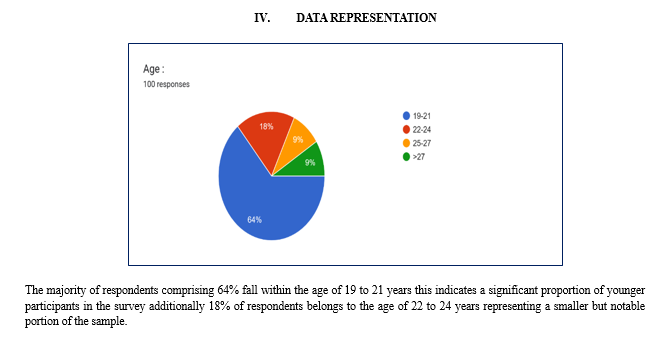

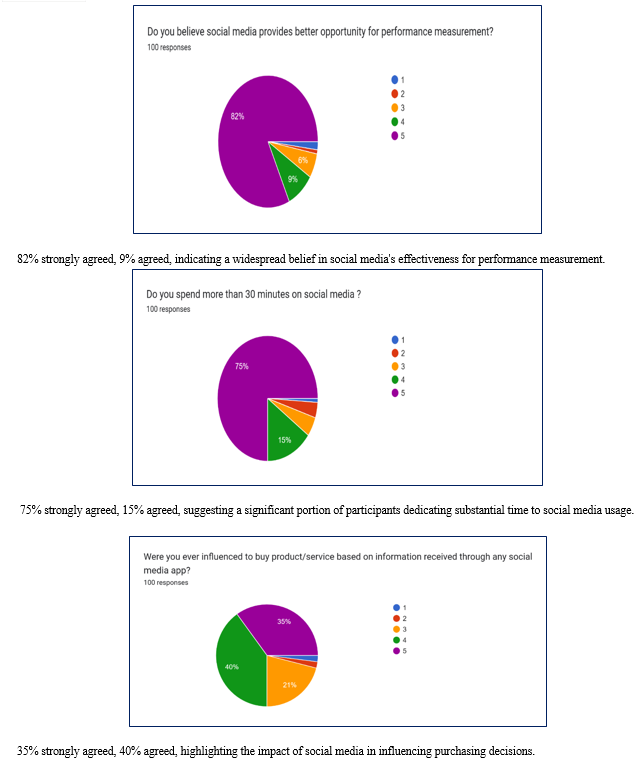
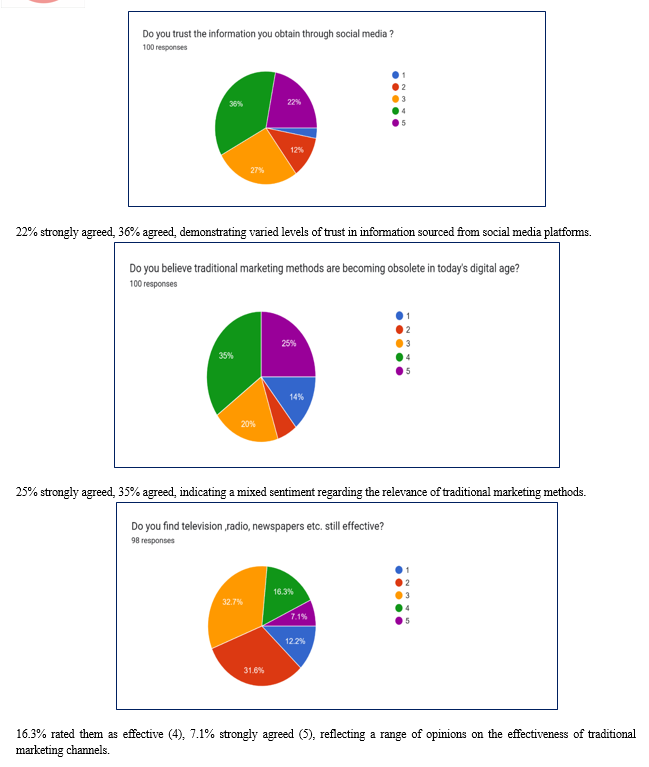
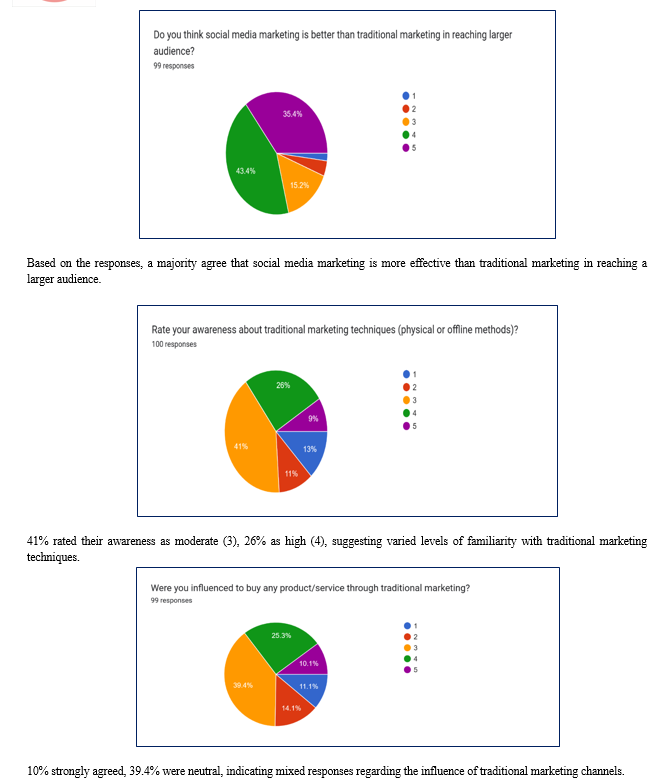
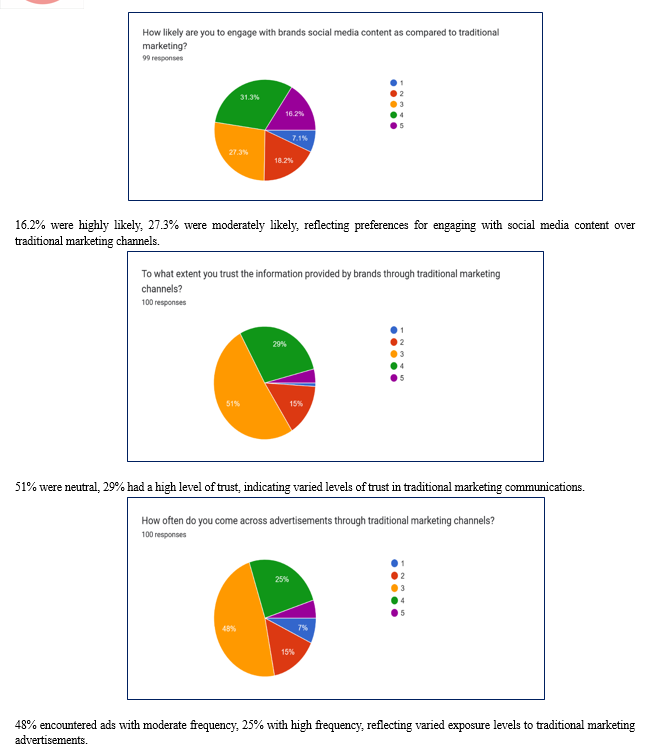
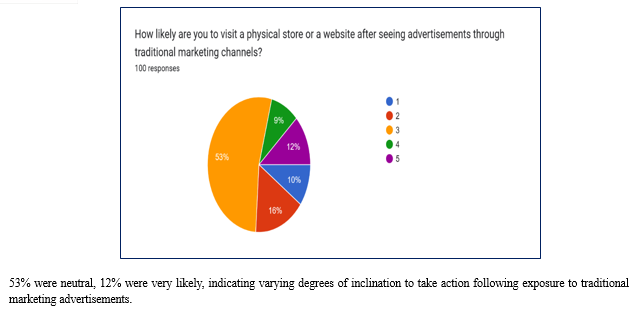
V. DATA ANALYSIS
In this chapter, I delved into the analysis of the collected data to evaluate the effectiveness of social media marketing compared to traditional marketing methods. Through statistical tests and comparisons, I aim to discern any significant differences in success rates between the two marketing approaches.
F-Test for Comparing Variances: The F-test serves as a statistical tool for comparing the variability, or variances, between two groups or populations. In this study, I did the F-test to compare the variance of success rates between social media marketing and traditional marketing.
A. Analysis
Upon conducting the F-test using the collected data, we obtained the following results:
- Mean: The average success rate of Social Media Marketing is 4.17, while for Traditional Marketing, it is 3.17. This indicates the typical level of success achieved by each marketing approach.
- Variance: The variance for Social Media Marketing is 0.215, and for Traditional Marketing, it is 0.42. This measures how spread out the success rates are within each marketing approach. A lower variance suggests more consistency in success rates, while a higher variance indicates greater variability.
- Observations (N): Both Social Media Marketing and Traditional Marketing had one hundred observations each, representing the number of respondents who participated in the survey.
- Degrees of Freedom (DF): With 100 observations for each group, the degrees of freedom for both Social Media Marketing and Traditional Marketing are ninety-nine. Degrees of freedom represent the number of independent pieces of information available for estimating parameters, such as variance.
- F-Value: The calculated F-value is 0.513, which compares the variability between Social Media Marketing and Traditional Marketing. This test statistic indicates the extent of difference in variances between the two marketing approaches.
- P-Value: The obtained p-value is 0.00051, which is less than the chosen significance level (α = 0.05). This indicates that the observed difference in variances between Social Media Marketing and Traditional Marketing is statistically significant. It is highly unlikely to occur by random chance alone.
- Critical F-Value: The critical F-value for a one-tailed test is 0.717. It serves as the threshold value used to determine whether the observed difference in variances is statistically significant. Comparing it to the calculated F-value helps in making decisions in hypothesis testing.


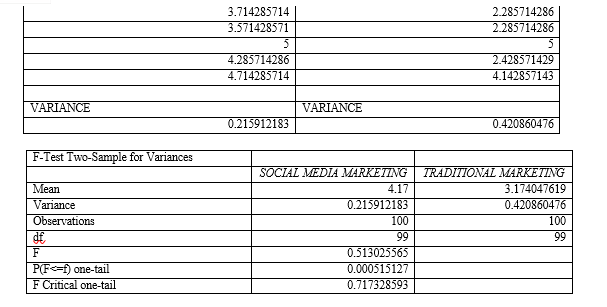
VI. KEY FINDINGS
- Preference for Social Media Marketing
- Social media marketing is increasingly recognized for its effectiveness in reaching and engaging target audiences.
- Consumers appreciate brands that respond directly to them on social media platforms, indicating the importance of social media for customer service and support.
- Social media marketing offers advantages such as cost-effectiveness, rapid dissemination of information, and the ability to generate user-generated content.
2. Advantages of Traditional Marketing
- Traditional marketing still holds relevance, particularly for targeting older audiences who may be more receptive to conventional mediums like television.
- While traditional marketing channels incur higher expenses and may have difficulty reaching target audiences effectively, they are still perceived as somewhat effective or very effective by a massive portion of respondents.
- Traditional marketing methods aim to engage with potential buyers directly and leverage mass communication channels to convey messages to a wide audience.
3. Consumer Behaviour and Influence
- Both social media marketing and traditional marketing influence consumer behaviour and purchasing decisions.
- Social media marketing has been shown to impact brand loyalty and consumer purchasing behaviour, with platforms like Instagram being highlighted as effective for online shopping.
- Traditional marketing, despite its challenges, still influences consumer behaviour, with a majority of respondents reporting being influenced to buy a specific product from traditional marketing.
4. Evaluating Success Rates
- Success rates for both social media marketing and traditional marketing depend on several factors such as target audience demographics, industry, marketing objectives, and the effectiveness of the marketing strategies employed.
- While social media marketing is gaining momentum and recognition for its cost-effectiveness and ability to engage with consumers, traditional marketing still holds importance and relevance in reaching specific demographics and conveying brand messages effectively.
In conclusion, while social media marketing is increasingly favoured for its cost-effectiveness, engagement, and ability to reach target audiences, traditional marketing methods still play a significant role in influencing consumer behaviour and driving brand success. The success of each marketing approach depends on several factors, and a balanced approach that incorporates both social media marketing and traditional marketing strategies may be the most effective for businesses in today's dynamic marketing landscape.
A. Practical Implications
The practical implications of this study lie in guiding businesses to make informed decisions regarding their marketing strategies. By understanding the strengths and weaknesses of both SMM and traditional marketing, organizations can allocate resources more effectively, tailor their messaging to target audiences, and maximize overall marketing success.
B. Originality
This study contributes to the existing literature by providing a comprehensive analysis of the comparative effectiveness of SMM and traditional marketing. By synthesizing insights from various sources and offering practical recommendations, the study adds value to the field of marketing research and aids businesses in navigating the complex landscape of modern marketing.
C. Keywords
Social media marketing, traditional marketing, comparative analysis, effectiveness, reach, engagement, resource allocation, consumer behaviour, marketing strategy
Conclusion
1) Analysis Result: The F-test revealed statistically significant differences in success rates between Social Media Marketing and Traditional Marketing strategies. This suggests that one approach may be more effective than the other in reaching and engaging target audiences. 2) Statistical Significance: With a p-value of 0.00051, which is well below the significance level (? = 0.05), the observed differences cannot be attributed to random chance alone. This strengthens the validity of the findings and underscores the importance of the observed disparities. 3) Effect Size: The moderate effect size (F = 0.51) indicates that the differences in success rates between the two marketing methods are not trivial but rather meaningful in practical terms. This implies that businesses should carefully consider which strategy aligns best with their objectives and resources. 4) Business Implication: These findings carry significant implications for businesses aiming to optimize their marketing efforts. Choosing the most suitable marketing strategy can lead to improved brand visibility, customer engagement, and ultimately, profitability. 5) Market Strategy: It is essential for businesses to conduct thorough market analysis, considering factors such as target demographics, industry trends, and competitor strategies. By aligning marketing efforts with market dynamics, organizations can enhance their competitive edge and market positioning. 6) Competitive Advantage: A nuanced understanding of the strengths and weaknesses of both social media and Traditional Marketing approaches can provide businesses with a competitive advantage. By leveraging the unique benefits of each method, organizations can tailor their marketing strategies to effectively meet the evolving needs and preferences of their target audience.
Copyright
Copyright © 2024 Khushi Jain. This is an open access article distributed under the Creative Commons Attribution License, which permits unrestricted use, distribution, and reproduction in any medium, provided the original work is properly cited.

Download Paper
Paper Id : IJRASET62335
Publish Date : 2024-05-18
ISSN : 2321-9653
Publisher Name : IJRASET
DOI Link : Click Here
 Submit Paper Online
Submit Paper Online

